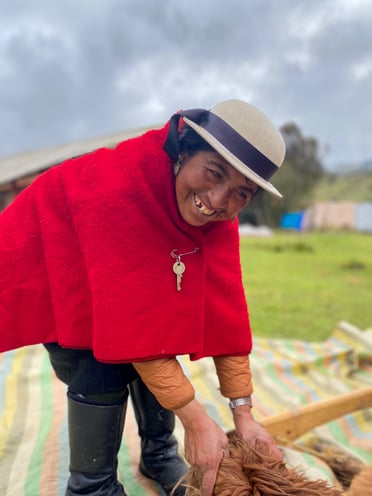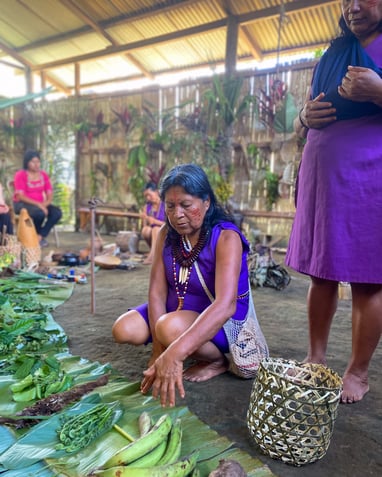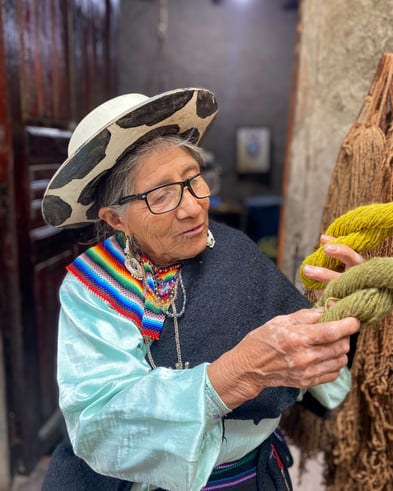 There are 476 million Indigenous people living across the globe, about 5% of the world’s population. This surpasses Europe’s population by about 20 million people.
There are 476 million Indigenous people living across the globe, about 5% of the world’s population. This surpasses Europe’s population by about 20 million people.
It is also estimated that the world's Indigenous population speaks about 4,000 different languages, compared to the 24 official and 200 spoken languages in Europe.
And language is just one component of culture, of which there are many more to explore. Each culture is its own world, full of knowledge, stories, and richness.
In order to safeguard and protect cultural heritage, there is a movement of Indigenous tourism going on. Indigenous Tourism, or First Nations Tourism, refers to tourism businesses that are mainly owned, managed, and run by Indigenous people. The aim is to strengthen the connection and responsibility to the local Indigenous community and the traditional territories where tourism operations are based.
Why do some Indigenous communities opt for tourism?
An issue that many Indigenous communities face is that they do not own their own land, whether they have been living there for generations or have been expelled from their traditional territory. This is compounded by the fact that the rural areas inhabited by Indigenous peoples are often rich in resources such as natural gas, oil, or minerals, or play a significant role in hydropower energy production. This intensifies the potential for conflict around land rights, especially when it comes to infrastructure and extraction projects that involve Indigenous communities, the state, and the private sector.
Moreover, indigenous people are more likely to suffer poverty and malnutrition due to a lack of a social safety net or economic resources. The work opportunities available often leave them vulnerable to human rights violations. Many Native groups face difficulties accessing education and healthcare, which also limits their opportunities and increases the risk of marginalization. This affects women even more drastically.
 Indigenous Tourism is a response to this situation and the need to defend collective rights. Engaging in tourism can strengthen a community and support efforts to reclaim territorial rights. Tourism activity in the territory where they live helps create jobs and the possibility to remain on the land. Tourism services linked to handicrafts, gastronomy, or accommodation services often lead to women driving those businesses, giving them a chance to earn a salary independent of a partner, challenging gender-based social structures.
Indigenous Tourism is a response to this situation and the need to defend collective rights. Engaging in tourism can strengthen a community and support efforts to reclaim territorial rights. Tourism activity in the territory where they live helps create jobs and the possibility to remain on the land. Tourism services linked to handicrafts, gastronomy, or accommodation services often lead to women driving those businesses, giving them a chance to earn a salary independent of a partner, challenging gender-based social structures.
Engaging in tourism also represents a path to reconstructing historical and ancestral memory, including traditions that indigenous people may have abandoned themselves so that their children would not be excluded due to their race or language. Therefore, through tourism, culture is also safeguarded.
All this being said, it must be noted that tourism is no panacea, and It is crucial that tourism remains an optional income stream which strengthens other economic activities, instead of replacing them.
How is Indigenous tourism different from other touristic activities?

Indigenous tourism is deeply rooted in the culture of the host community. It is intertwined with their traditions, cosmovision, and communal way of life. It is very distinct from tourism services that are provided without any attachment to local culture. And since Indigenous cultures are very connected to nature, along with ancestral knowledge that has been passed down through the generations, tourism also opens the door for visitors to learn and connect with nature in a way they might not have experienced before.
Research indicates that when Indigenous communities have land control, biodiversity flourishes. This shows that this type of tourism and cross-cultural exchange is also beneficial for environmental protection.
Tourism in Indigenous communities also counteracts difficulties people might have accessing decent jobs, a lack of education, or the lack of public infrastructure in the territory. Tourism therefore becomes an economic force in the community, at the same time as promoting cross-cultural understanding and supporting Indigenous people in recovering ancestral knowledge.
Indigenous Tourism in Latin America
Approximately 8.3% of Latin America's population is attributed to Indigenous groups. This does not take into account mestizo groups—those with a blend of Spanish and Indigenous heritage—which may not appear in statistics.
 Indigenous groups in Latin America suffer from social inequality, with the state and rule of law scarcely present or entirely absent in rural regions. There is less health, education, and transportation Infrastructure available to Indigenous peoples, especially compared to urban residents.
Indigenous groups in Latin America suffer from social inequality, with the state and rule of law scarcely present or entirely absent in rural regions. There is less health, education, and transportation Infrastructure available to Indigenous peoples, especially compared to urban residents.
To overcome the current deficit in representation, several Indigenous groups in Latin American countries are organizing to advocate for and advance their collective rights and the recognition of their culture. The increasing amount of Indigenous tourism groups and organizations, especially in countries like Ecuador and Bolivia, show the dedication of this movement to improve quality of life.
And international travelers are rewarded by being given more meaningful, impactful, and transformative ways to travel. It’s why V Social is committed to community-based tourism initiatives and supporting the efforts of Indigenous groups. They are a true example of the power of travel, and how tourism can be a force for good.









